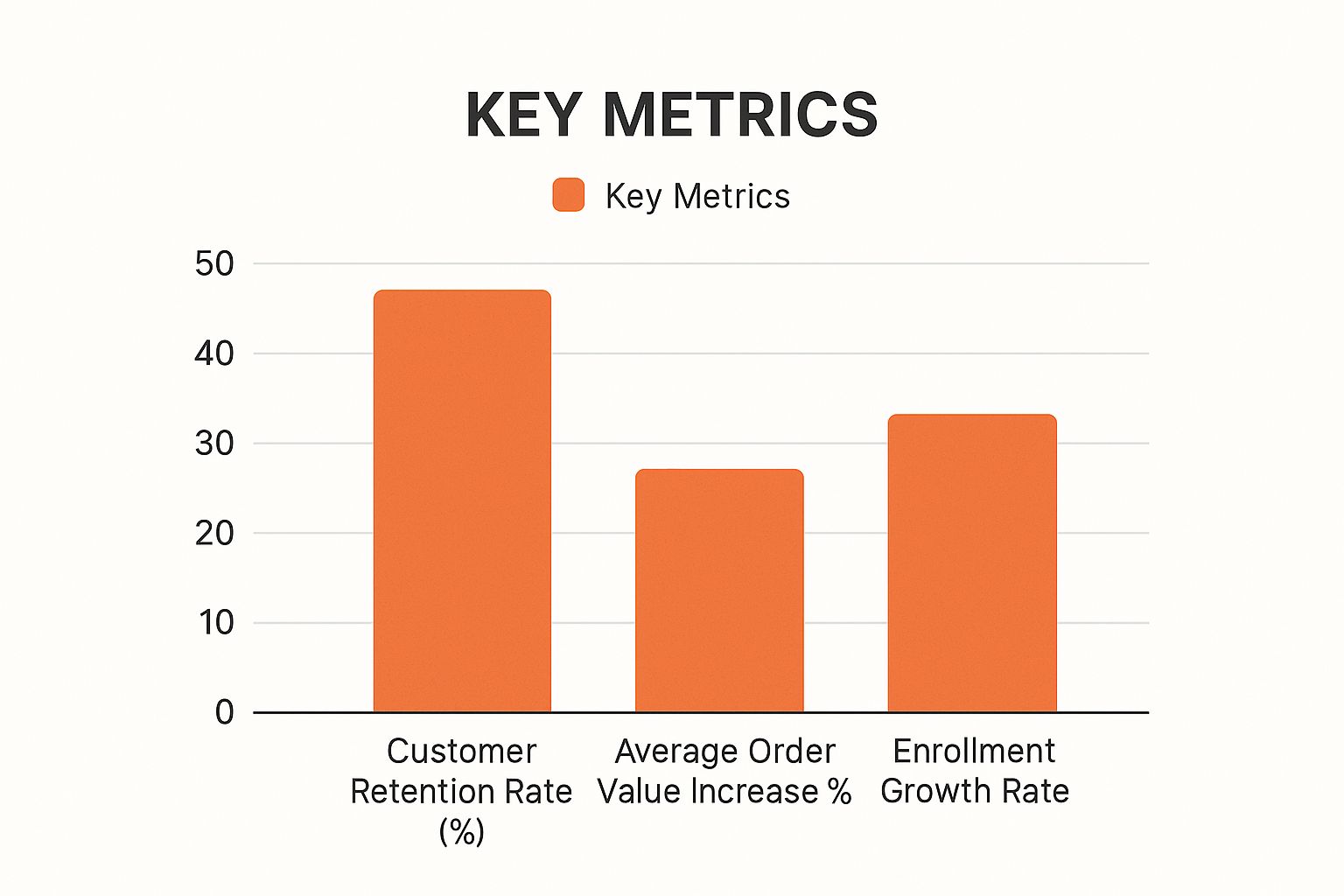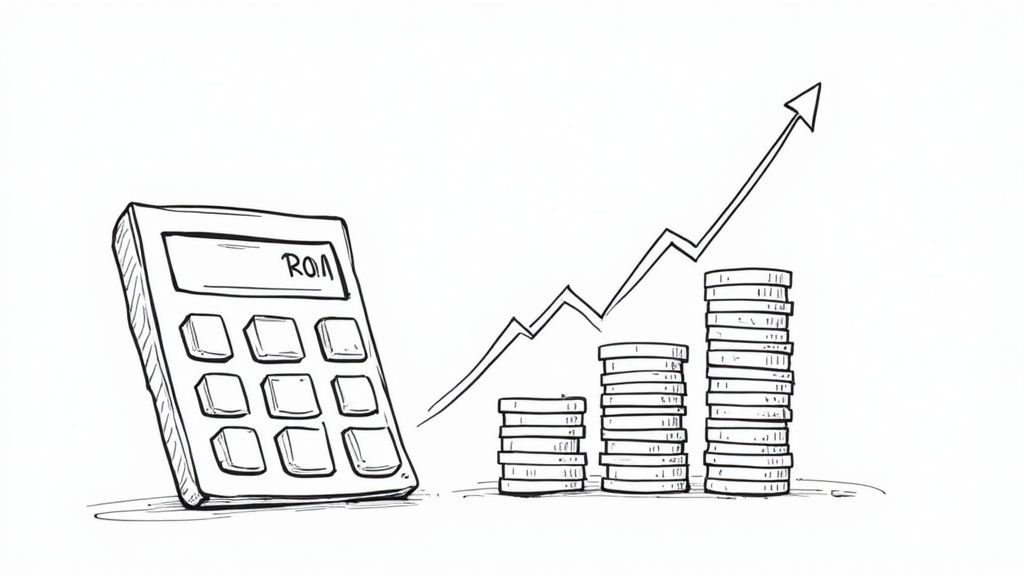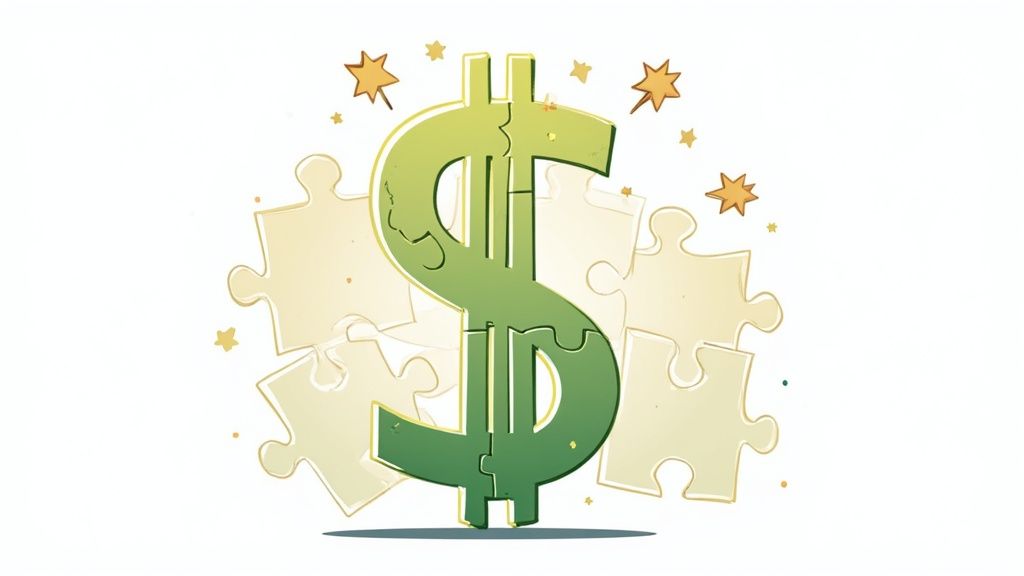Boost Your Loyalty Program ROI with Proven Strategies
The Real Business Case for Loyalty Program ROI

Loyalty programs are more than just collecting points for purchases. They are a strategic investment in customer relationships that directly impacts your bottom line. Understanding and measuring loyalty program ROI is essential for sustainable business growth. Effectively structured programs can significantly increase customer lifetime value and boost overall revenue.
Beyond Points: The True Value of Engagement
Traditional ROI calculations often focus on immediate financial returns. However, modern loyalty programs require a broader perspective, one that considers the behavioral impacts of the program. Measuring metrics like increased purchase frequency, average order value, and customer retention rate provides a more comprehensive view of a program's success. These shifts in customer behavior often precede significant financial gains.
Loyalty programs deliver significant ROI, with approximately 90% of loyalty program owners reporting positive ROI in 2025. The average ROI for these programs is about 4.8 times the initial investment. This high return is fueled by increased spending and improved retention among loyalty members. For example, members who actively redeem rewards spend 3.1 times more annually than non-redeeming members. For more detailed insights, explore these Loyalty Program Statistics.
Customizing Your ROI Framework
Different business models require different approaches to measuring loyalty program ROI. A subscription-based service, for instance, will prioritize different metrics than a traditional retail store. Understanding your specific business goals is the first step in creating an effective measurement framework. Seeing real-world examples can be invaluable in this process. For further information, consider this guide on Shopify Loyalty Programs.
From Transactions to Lifetime Value
The way we measure loyalty program ROI has evolved, shifting from a focus on short-term gains to long-term value creation. While early programs primarily tracked transactions, today’s models emphasize customer lifetime value (CLV). Instead of simply rewarding individual purchases, programs are now designed to nurture lasting customer relationships. This results in higher CLV and increased profitability. This more comprehensive approach considers both immediate financial returns and the long-term effects on customer behavior and loyalty.
Measuring What Actually Matters: Key Loyalty Program Metrics
Moving beyond superficial metrics like total membership is crucial for truly grasping your loyalty program's impact. This involves concentrating on actionable metrics that directly fuel business growth and offer insights into program effectiveness. Successful loyalty program managers differentiate between lagging indicators, like overall membership numbers, which reflect past performance, and leading indicators, such as customer lifetime value (CLV) or repeat purchase rate, which offer a glimpse into future potential.
Identifying Actionable Metrics
To effectively measure loyalty program ROI, track metrics that paint a clear picture of member behavior and its link to revenue.
-
Customer Retention Rate: This metric measures the percentage of customers who remain engaged with your brand over a specific period. A higher retention rate signifies a successful loyalty program.
-
Average Order Value Increase: Monitor how much more loyalty program members spend per order compared to non-members. A notable increase suggests the program is encouraging higher spending.
-
Enrollment Growth Rate: While total membership can be a vanity metric, a healthy enrollment growth rate indicates the program is attracting new customers.
-
Redemption Rate: This metric reveals how often members use their earned rewards. A low redemption rate may suggest that the rewards aren't appealing or the redemption process is too cumbersome.

The infographic above compares three key loyalty program metrics: Customer Retention Rate, Average Order Value Increase, and Enrollment Growth Rate. The data often shows a strong correlation between improved customer retention and increased average order value, highlighting the importance of focusing on long-term engagement rather than simply acquiring new members.
To further illustrate the diverse metrics used in measuring loyalty program success, consider the following table:
Essential Loyalty Program ROI Metrics
A comprehensive comparison of financial vs. behavioral metrics for measuring loyalty program performance
| Metric Category | Specific Metrics | Calculation Method | Business Impact | Implementation Complexity |
|---|---|---|---|---|
| Financial | Customer Lifetime Value (CLV) | Average Purchase Value x Average Purchase Frequency x Average Customer Lifespan | Predicts future revenue from loyal customers | Moderate |
| Financial | Return on Investment (ROI) | (Program Revenue - Program Cost) / Program Cost | Measures program profitability | Moderate |
| Behavioral | Customer Retention Rate | (# of Customers at End of Period - # of New Customers Acquired During Period) / # of Customers at Start of Period | Gauges customer loyalty and program effectiveness | Easy |
| Behavioral | Repeat Purchase Rate | # of Customers Making Multiple Purchases / Total # of Customers | Tracks repeat business and customer engagement | Easy |
| Behavioral | Redemption Rate | # of Rewards Redeemed / # of Rewards Issued | Measures reward attractiveness and redemption process efficiency | Easy |
This table provides a clear comparison of different metrics, categorized by their focus – either financial or behavioral. By considering both types, businesses can gain a more comprehensive understanding of their loyalty program's performance.
Building a Meaningful Measurement Framework
Developing a robust measurement framework involves aligning your metrics with your specific business goals. For subscription services, metrics like churn rate and lifetime subscription value are vital. Retailers benefit from focusing on repeat purchase rate and customer acquisition cost (CAC) through referrals. Experience-based brands might prioritize metrics like customer satisfaction and Net Promoter Score (NPS). For more in-depth information, you might be interested in this article: How to Calculate the ROI of Your Loyalty and Retention Initiatives.
Avoiding Measurement Pitfalls
A common mistake is focusing solely on short-term gains. A successful loyalty program requires a long-term perspective, analyzing trends over time rather than fixating on individual campaign results. Avoid data overload by selecting a manageable set of key metrics and building clear, insightful dashboards to visualize program progress, identify areas for improvement, and make data-driven decisions.
Customizing for Different Business Models
Implementing a loyalty program means tailoring your approach to your unique business model. Subscription-based businesses might emphasize retention metrics like churn reduction and renewal rates. Retailers may focus on increasing purchase frequency and average order value. Experience-based businesses could prioritize customer satisfaction and advocacy through social sharing.
Measuring the Impact of Personalized Experiences
Personalization is key to boosting loyalty program ROI. Tracking metrics such as offer redemption rates for targeted segments reveals the effectiveness of personalization efforts. Analyzing changes in customer behavior after implementing personalized rewards offers valuable insights into member preferences and overall engagement impact.
Navigating The Loyalty Landscape For Better Returns

The loyalty landscape is always changing. This presents both challenges and opportunities for businesses looking to improve their loyalty program ROI. As digital technologies advance, customer expectations evolve. Brands must adapt their strategies to keep up. This means going beyond simple transactional rewards to build stronger emotional connections that lead to real business growth.
Embracing The Digital Shift In Loyalty
Digital transformation has fundamentally changed how customers interact with brands. Loyalty programs need to offer seamless, personalized experiences across every touchpoint. This includes mobile apps, social media, and in-store interactions, all working together. For example, personalized push notifications based on past purchases or browsing history can re-engage customers and encourage them to return.
Beyond Transactions: Building Emotional Connections
Today's consumers want more than just discounts. They're looking for experiences that align with their values and make them feel appreciated. This means focusing on emotional connections. Think exclusive event access, early product releases, or even personalized birthday messages. These small gestures can build long-term loyalty and increase loyalty program ROI.
The global loyalty programs market demonstrates this shift, with remarkable growth driven by these changing dynamics. In 2024, the global loyalty management market was valued at approximately $13.31 billion. It's projected to reach $93.79 billion by 2025, a massive year-over-year growth of 15.9%. By 2029, the market is expected to hit $155.22 billion, expanding at a 13.4% CAGR. Find more statistics here.
Exploring Emerging Loyalty Models
Innovative programs are testing new models to achieve better ROI. Subscription-based loyalty, where members pay a recurring fee for exclusive benefits, offers a predictable revenue stream. Tiered membership structures encourage higher spending with increasingly valuable rewards. Partner ecosystems broaden a program's appeal by offering rewards from complementary businesses.
Adapting To Regional Nuances
Loyalty program success varies across different regions. Cultural factors, economic conditions, and technology adoption rates all play a role. This requires a tailored approach. For example, offering localized rewards or incorporating cultural elements can significantly improve engagement and ROI in certain markets. Adaptability is crucial for the future of your loyalty program. By embracing innovation and prioritizing personalized experiences, brands can maximize their loyalty programs and achieve impressive returns.
Personalization That Pays: Boosting Loyalty Program ROI
Personalization is key to maximizing the ROI of your loyalty program. Leading brands are going beyond simple segmentation. They use behavioral data, purchase history, and predictive analytics to create highly relevant experiences for their members. This provides real value, encouraging continued participation and boosting returns.
Understanding Your Members' Needs
Effective personalization begins with understanding your members as individuals. Analyzing their past interactions with your brand helps anticipate their needs and preferences. This data allows you to offer tailored rewards, personalized recommendations, and targeted communications that enhance the member experience and build appreciation.
For example, a coffee shop loyalty program could use purchase history to suggest new drinks based on previous orders, rather than offering a generic discount. A personalized birthday reward can also demonstrate genuine appreciation for the individual member.
Building the Technology Infrastructure
Advanced personalization requires the right technology. This includes investing in robust AI-powered recommendation engines like Recombee, real-time engagement tools, and a centralized data platform to manage large amounts of customer data. These tools help automate personalized communications and deliver targeted offers efficiently, maximizing impact.
Gamification: Enhancing the Experience
Gamification adds another layer of engagement to loyalty programs. Incorporating elements like challenge-based rewards, achievement systems, and progress tracking taps into members' competitive spirit and encourages desired behaviors. This makes the program more interactive and enjoyable, driving participation and spending.
Measuring Success and Demonstrating ROI
The growing emphasis on customer lifetime value (CLV) and churn reduction demonstrates the effectiveness of these strategies. Around 60% of brands prioritize CLV as a key metric, and 38% focus on reducing churn through loyalty initiatives. Companies investing in personalization see over 40% higher reward redemption rates. Furthermore, 43% of brands utilize gamification to boost engagement. Learn more about loyalty program trends here.
Implementation Frameworks and Benchmarks
Implementing personalized loyalty programs requires a structured approach. Start by defining clear goals and identifying key metrics. Then, segment your audience based on shared characteristics and behaviors. Design personalized reward structures and communication strategies for each segment. Finally, continuously monitor and refine your approach based on performance data.
For more on driving revenue with customer loyalty and engagement, see 5 Ways to Drive Revenue With Customer Loyalty and Engagement. A strategic, data-driven approach helps brands create loyalty programs that reward customers and deliver exceptional ROI.
Loyalty Transformation Stories: From Struggling to Stellar ROI

Real-world success stories offer compelling evidence of a well-executed loyalty program's potential. This section explores how businesses across various industries have transformed struggling programs into powerful growth engines, achieving stellar loyalty program ROI. We'll examine the initial challenges, strategic redesigns, implementation processes, and quantifiable results.
Turning Challenges into Opportunities
Many businesses, both established brands and emerging players, encounter common hurdles with their loyalty programs. These often include low member engagement, a lack of personalization, and difficulty demonstrating clear ROI. However, strategically addressing these challenges can unlock substantial growth opportunities.
For example, one retailer struggled with a traditional points-based system that didn't resonate with customers. The program lacked excitement and offered little perceived value. By incorporating personalized rewards, tiered benefits, and experiential elements, the retailer witnessed a dramatic increase in both member engagement and spending.
The Power of Strategic Redesign
Revitalizing an underperforming loyalty program requires a strategic approach. This involves reassessing the program's core value, identifying target customer segments, and designing a reward structure that truly incentivizes desired behaviors.
Consider a hospitality brand whose existing program offered generic discounts with limited appeal. By implementing a tiered membership structure with exclusive perks, like early check-in and room upgrades, the brand significantly increased customer lifetime value and loyalty program ROI. In addition to loyalty programs, understanding influencer marketing ROI is also crucial. For more on measuring influencer marketing ROI, check out this helpful resource: How to Measure Influencer Marketing ROI.
Implementation and Resource Allocation
Successful implementation involves careful planning, resource allocation, and ongoing monitoring. A clear timeline, a dedicated team, and the appropriate technology infrastructure are essential for success.
One subscription business initially faced challenges integrating its loyalty program with existing systems. Investing in a robust loyalty platform like Toki streamlined operations, personalized the member experience, and provided valuable data insights. This not only improved loyalty program ROI but also enhanced overall customer satisfaction.
Quantifiable Results and ROI
Ultimately, a loyalty program's success is measured by its impact on key business metrics. This includes revenue growth, customer retention, and increased customer lifetime value.
Across various industries, transformed loyalty programs have delivered impressive ROI. One financial services company saw a 30% increase in customer retention after implementing a personalized rewards program. A hospitality brand achieved a 20% uplift in revenue through a tiered membership system. These results highlight the potential of strategic loyalty programs to drive significant business growth. For further insights into the evolving landscape of loyalty programs, read our article: How Loyalty Is Changing.
To illustrate the potential ROI of loyalty programs across different sectors, let's examine some industry benchmarks. The following table presents a statistical comparison of key performance metrics.
Loyalty Program ROI Benchmarks by Industry
| Industry | Average ROI Multiple | Member vs. Non-Member Spend Increase | Retention Rate Improvement | Average Implementation Timeframe | Key Success Factors |
|---|---|---|---|---|---|
| Retail | 5x | 25% | 15% | 6-12 months | Personalized offers, exclusive access |
| Hospitality | 7x | 30% | 20% | 9-18 months | Tiered benefits, experiential rewards |
| Financial Services | 3x | 15% | 10% | 3-6 months | Data-driven personalization, relevant rewards |
| Subscription Services | 4x | 20% | 12% | 6-9 months | Seamless integration, proactive engagement |
This table demonstrates the potential for significant returns across various sectors. Key success factors include personalized offers, tiered benefits, and seamless integration with existing systems.
These examples showcase the tangible benefits of transforming a struggling loyalty program. By learning from these success stories, businesses can gain valuable insights and apply them to their own loyalty initiatives.
Future-Proofing Your Loyalty Program's Return on Investment
Maintaining a strong loyalty program ROI requires adapting to the ever-changing landscape of consumer behavior and technology. Understanding current trends and anticipating future ones is key. Smart brands are exploring and testing emerging innovations to stay competitive. This section examines some of these advancements and their potential impact on ROI.
Blockchain-Based Rewards: Transparency and Security
Blockchain technology offers exciting possibilities for loyalty programs. Its decentralized and secure nature can increase transparency and build trust with members. Blockchain allows secure tracking of rewards, reducing fraud and enhancing the member experience. It also enables fractional ownership of rewards and easier transferability, increasing their perceived value. However, implementation costs can be substantial and require careful consideration.
Integrating Virtual Experiences: Engaging the Digital Native
The rise of the metaverse and virtual experiences presents new opportunities for loyalty program engagement. Integrating these digital environments allows brands to offer unique, immersive experiences. Imagine a fashion brand offering virtual try-on experiences or exclusive access to virtual fashion shows for loyalty members. These unique experiences can boost engagement and drive emotional connections.
Seamless Biometric Authentication: Enhancing Convenience
Biometric authentication, such as facial recognition or fingerprint scanning, can streamline the customer journey. This technology makes it easier for members to identify themselves and redeem rewards, reducing friction and improving satisfaction. However, balancing convenience with data privacy is crucial. Careful consideration of ethical implications and adherence to privacy regulations is essential.
Sustainability-Focused Initiatives: Aligning With Values
Consumers are increasingly conscious of social responsibility. Integrating sustainability initiatives into loyalty programs can resonate with values-driven customers. This might involve rewarding eco-friendly choices, supporting charities, or offering sustainable product options. Aligning with customer values strengthens connections and enhances loyalty program ROI.
Evaluating Emerging Innovations
Evaluating these emerging technologies through the lens of ROI is crucial. A thorough cost-benefit analysis, comparing implementation costs against the potential return, is necessary. Realistic timelines for deployment are also essential, considering the complexity of integration and potential staff training needs.
Addressing Future Challenges
The future of loyalty programs involves addressing potential challenges. Increased competition for customer attention demands creativity and compelling value propositions. Evolving privacy regulations require careful data management and transparent communication. Shifting consumer expectations necessitate a continuous evolution of loyalty program offerings and a focus on authentic relationships.
Boost your loyalty program's ROI with Toki, the all-in-one loyalty platform designed for Shopify and other e-commerce merchants. Discover how Toki can transform your loyalty program today!